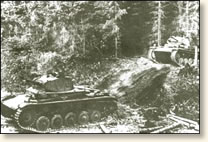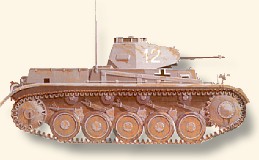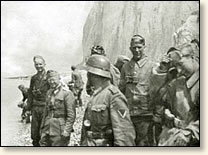|
Blitzkrieg, 1940
The period between Germany's
defeat of Poland in October 1939 and her invasion of Norway in April 1940 is
often
referred
to as the "Phony War." Not much happened. The French stiffened their defenses
while the British moved troops to the continent. The British wanted to send their
air force to bomb targets inside Germany but were persuaded not to by the French
who feared German reprisal. The major activity consisted of dueling propaganda
messages blared from loud speakers across the German and French lines.
The French, feeling secure behind their Maginot Line, were ready to fight World
War I all over
 |
| Panzers in action, France 1940 |
again - a war of defense. Hitler had other ideas. In order to
isolate the iron ore resources of Sweden, and secure his northern flank, Hitler
invaded Norway and Denmark on April 9.
The next blow came a month later. In the early morning darkness of May 10, the Germans unleashed their Blitzkrieg against the Netherlands and Belgium. The attack sent the defending troops reeling. The roads overflowed with refugees fleeing the front. French and British troops rushing to the rescue were caught in the headlong retreat and pushed back. German dive-bombers - the Stukas - filled the sky, strafing the retreating mix of civilians and soldiers with machine gun and bomb. The Allies fought valiantly but in vain - the German war machine advanced unperturbed.
In England, the invasion forced Prime Minister Neville Chamberlain to resign, to be replaced by Winston Churchill.
The Germans defied military doctrine, skirted the Maginot Line and slashed into
France through Luxembourg and the Ardennes Forest. The Blitzkrieg moved with
lightning speed as Hitler's tanks turned and raced headlong to the sea. They
reached the English Channel on May 21 cutting off the Allied armies in the
North.
The Germans turned again, fighting their way north to secure the coastal ports and annihilate the trapped armies. Miraculously, the German high command called a halt to the advance. The reprieve lasted 48 hours, long enough for the British to defend Dunkirk and evacuate what they could of the Allied armies. The Germans entered Paris on June 14. In a humiliating ceremony on June 22, France signed an armistice with Germany, leaving Britain to carry on the fight alone.
General Erwin Rommel, who would later gain fame in the African desert as the "Desert Fox", led the 7th Panzer Division as it crashed through the Belgian defenses into France, skirting the Maginot Line and then smashing it from behind. This was a new kind of warfare integrating tanks, air power, artillery, and motorized infantry into a steel juggernaut emphasizing speedy movement and maximization of battlefield opportunities. Rommel kept a journal of his experiences. In this excerpt, he describes the action on May 14 as he leads a tank attack against French forces near the Muese River on the Belgian border:
"Rothenburg [a subordinate tank commander] now drove off through a hollow to the left with the five tanks which were to accompany the infantry, thus giving these tanks a lead of 100 to 150 yards. There was no sound of enemy fire. Some 20 to 30 tanks followed up behind. When the commander of the five tanks reached the rifle company on the southern edge of Onhaye wood, Colonel Rothenburg moved off with his leading tanks along the edge of the wood going west. We had just reached the southwest corner of the wood and were about to cross a low plantation, from which we could see the five tanks escorting the infantry below us to our left front, when suddenly we came under heavy artillery and anti-tank gunfire from the west. Shells landed all round us and my tank received two hits one after the other, the first on the upper edge of the turret and the second in the periscope.
The driver promptly opened the throttle wide and drove straight into the nearest bushes. He had only gone a few yards, however, when the tank slid down a steep slope on the western edge of the wood and finally stopped, canted over on its side, in such a position that the enemy, whose guns were in position about 500 yards away on the edge of the next wood, could not fail to see it. I had been wounded in the right check by a small splinter from the shell which had landed in the periscope. It was not serious though it bled a great deal.
I tried to swing the turret round so as to bring our 37 mm-gun to bear on the enemy in the opposite wood, but with the heavy slant of' the tank it was immovable.
 The French battery now opened rapid fire on our wood and at any moment we could
expect their fire to be aimed at our tank, which was in full view. I therefore
decided to abandon it as fast as I could, taking the crew with me. At that
moment the subaltern in command of the tanks escorting the infantry reported
himself wounded, with the words: 'Herr General, my left arm has been shot off.'
We clamored up through the sandy pit, shells crashing and splintering all round.
Close in front of us trundled Rothenburg's tank with flames pouring out of
the rear. The adjutant of the Panzer Regiment had also left his tank. I thought
at first that the command tank had been set alight by a hit in petrol tank
and was extremely worried for Colonel Rothenbttrg's safety. However, it turned
out to be only the smoke candles that had caught light, the smoke from which
now served us very well. In the meantime Lieutenant Most had driven my armored
signals vehicle into the wood, where it had been hit in the engine and now
stood immobilized. The crew was unhurt." The French battery now opened rapid fire on our wood and at any moment we could
expect their fire to be aimed at our tank, which was in full view. I therefore
decided to abandon it as fast as I could, taking the crew with me. At that
moment the subaltern in command of the tanks escorting the infantry reported
himself wounded, with the words: 'Herr General, my left arm has been shot off.'
We clamored up through the sandy pit, shells crashing and splintering all round.
Close in front of us trundled Rothenburg's tank with flames pouring out of
the rear. The adjutant of the Panzer Regiment had also left his tank. I thought
at first that the command tank had been set alight by a hit in petrol tank
and was extremely worried for Colonel Rothenbttrg's safety. However, it turned
out to be only the smoke candles that had caught light, the smoke from which
now served us very well. In the meantime Lieutenant Most had driven my armored
signals vehicle into the wood, where it had been hit in the engine and now
stood immobilized. The crew was unhurt."
Two days later, Rommel and his forces raced behind and parallel to the Maginot Line, and then turned north to attack the fortifications from behind. He describes the action as his tank formations plunge through the French defenses:
"The tanks now rolled in a long column through the line of fortifications and on towards the first houses, which had been set alight by our fire. In the moonlight we could see the men Of 7th Motorcycle Battalion moving forward on foot beside us. Occasionally an enemy machine-gun or anti-tank gun fired, but none of their shots came anywhere near us. Our artillery was dropping heavy harassing fire on villages and the road far ahead of the regiment. Gradually the speed increased. Before long we were 500 -1,000 - 2,000 - 3,000 yards into the fortified zone. Engines roared, tank tracks clanked and clattered. Whether or not the enemy was firing was impossible to tell in the ear-splitting noise. We crossed the railway line a mile or so
 |
German panzer troops reach
the French coast, June 10, 1940
A photo taken by Rommel |
southwest of Solre le Chateau, and then swung north to the main road which was soon reached. Then off along the road and past the first houses.
The people in the houses were rudely awoken by the din of our tanks, the clatter and roar of tracks and engines. Troops lay bivouacked beside the road, military vehicles stood parked in farmyards and in some places on the road itself. Civilians and French troops, their faces distorted with terror, lay huddled in the ditches, alongside hedges and in every hollow beside the road. We passed refugee columns, the carts abandoned by their owners, who had fled in panic into the fields. On we went, at a steady speed, towards our objective. Every so often a quick glance at the map by a shaded light and a short wireless message to Divisional H.Q. to report the position and thus the success of 25th Panzer Regiment. Every so often a look out of the hatch to assure myself that there was still no resistance and that contact was being maintained to the rear. The flat countryside lay spread out around us under the cold light of the moon. We were through the Maginot Line! It was hardly conceivable. Twenty-two years before we had stood for four and a half long years before this self-same enemy and had won victory after victory and yet finally lost the war. And now we had broken through the renowned Maginot Line and were driving deep into enemy territory. It was not just a beautiful dream. It was reality."
References:
Hart, B. H. Liddell, The Rommel Papers (1953); Horne, Alistair, To Lose a Battle, France, 1940 (1969).
How To Cite This Article:
"Blitzkrieg, 1940," EyeWitness to History, www.eyewitnesstohistory.com (2002).
|






